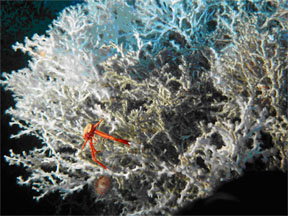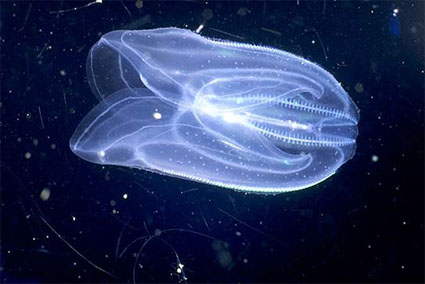Biodiversity in the European Seas
This article summarises the biodiversity in the European Seas. It is based on reports (publish date: 31 may 2002) of the ‘European Environmental Agency’ (visited 31/08/2007)(EEA), in which the marine biodiversity of each Sea is described in some detail. In the ‘EEA reports’ an overview is given of the most important physical, biological and exploitation characteristics, the main threats to biodiversity and the policies at work (nature protection and protection of marine resources by restrictions on fishing and hunting).The contents of these reports are shown together with an indication of the most relevant information.
Contents
The North Sea[1]
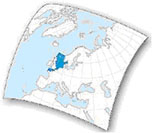
link to actual EEA report (visited: 31/08/2007)
The North Sea is a shallow sea (average depth: 90 m) with a surface area of 750 000 km². It is rather a young ecosystem formed by the flooding of a landmass some 20 000 years ago. Its coast and waters are still being colonized by new species from the Atlantic.
As main influences on the North Seas ecosystem are considered: fisheries, eutrophication, offshore industry, maritime traffic, industry and tourism.
The strong coupling between benthic and pelagic communities in the shallow parts of the sea makes it extremely productive and one of the most productive areas in the world, with a wide range of plankton, fish, seabirds and benthic communities. The North Sea is one of the world’s most important fishing grounds. The sea is also rich in oil and gas. Many human activities have an impact on the biodiversity of the North Sea. The marine ecosystems are under intense pressure from fishing, fish farming, kelp harvesting, invading species, nutrient input, recreational use, habitat loss and climate changes; most notable are the effects of fisheries and eutrophication.
The policy conducted in the North Sea has several objectives, from nature protection (discussed conventions/agreements are OSPAR, ICES, ASCOBANS and the Bonn Convention, Trilateral Wadden Sea Cooperation, North Sea Conference, EU Birds and Habitats Directives and Bern Convention) to protection of marine resources (ASCOBANS, the EU Common Fisheries Policy (CFP)). A marine spatial planning initiative in the North Sea funded through the European Union took place to help solve shared problems related to marine spatial development. An update of for Scotland and England has recently been undertaken.
Furthermore, there are several national, international and non-governmental organization initiatives to assess environmental quality in the North Sea area. The most important are: the ‘continuous plankton recorder’ (CPR), BioMar an the ‘Joint assessment and monitoring programme’ (JAMP).
The Baltic Sea[2]
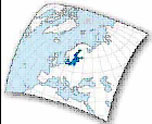
link to actual EEA report (visited 31/08/2007)
The Baltic Sea is the largest (surface area: 370 000 km²) brackish water system in the world. The shallow sounds between Sweden and Denmark provide a limited water exchange with the North Sea. It takes 25-35 years for all the water in the Baltic to be replenished by water from the North Sea and beyond.
The Baltic Sea has marked stratification between low-salinity surface water and the more saline deep water at a depth of about 40-70 m. This salinity barrier prevents the exchange of oxygen and nutrients, and large parts of the seabed are lifeless because of oxygen depletion. The vertical and horizontal salinity gradients are reflected in different species communities and species numbers. The highest biodiversity is found in the south-west of the Baltic Sea.
The Baltic Sea is slowly shrinking because of geological uplifting of land after the last glaciation.
Because of the geologically short time aspect (the Baltic Sea is formed after the last glaciation as the ice retreated some 10 000 years ago) and major changes, a very limited brackish water flora and fauna has developed. The Baltic Sea is therefore characterized by few species, but many individuals of each species.
The considered main threats to biodiversity are eutrophication, fisheries, pollution of oil and contaminants, constructions and introduction of non-indigenous species.
Nearly enclosed seas such as the Baltic are particularly sensitive to inputs of pollutants, because of the long residence time of the water (25 to 35 years). Although concentrations of most of the hazardous substances have decreased over the past 30 years in the Baltic area, a number of them are still of environmental concern, such as cadmium, dioxins and PCBs. One of the effects of contamination is sterility in a large part of the Baltic mammals population (probably due to PCB poisoning).
The discussed political instruments of application on the Baltic Sea are the Helsinki Convention of 1974 (HELCOM), the International Baltic Sea Fishery Commission (IBSFC), ASCOBANS, the Ramsar Convention, EU Birds and Habitats Directives, the Bern Convention and Natura 2000.
The Baltic Monitoring Programme, as part of COMBINE (Co-operative Monitoring in the Baltic Marine Environment), is implemented by the Helsinki Commission. The aims are to identify and quantify the effects of anthropogenic discharges/activities in the Baltic Sea in the context of the natural variations in the system, and to identify and quantify the changes in the environment as a result of regulatory actions.
The North-east Atlantic Ocean[3]
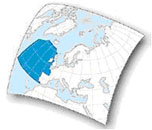
link to actual EEA report (visited 31/08/2007)
The North-east Atlantic Ocean is a part of the Atlantic Ocean. The morphology of the sea floor is dominated by two deep areas on both sides of the Mid Atlantic Ridge with depths down to 5 000 m and a shallow continental shelf along the European coast.
The formation of the North Atlantic deep water is one of the driving forces for the thermohaline circulation of the world’s oceans. The water flow is predominantly from west to east.
The primary productivity in the open ocean is low, but is increasing from south to north and towards shore. Cold-water reefs with Lophelia pertusa as the main reef building species are present along the coasts of the whole area. In deep water outside Scotland and Ireland there are large areas covered by cold water corals formed by two species, Lophelia pertusa and Madrepora oculata, which interconnect with tubes of the worm Eunice norvegicus. These deep-water reefs have a high biodiversity.
As main threats to biodiversity in the North-east Atlantic Ocean are considered: climatic changes, fisheries, mariculture, introduced species, eutrophication and pollution of oil and contaminants. The biodiversity is high, but several species in the area are endangered of which lack of sustainable fishery management is probably the most important threat. Eutrophication is not regarded as a problem for this sea except for some local coastal areas, mainly estuaries in the Celtic sea and some estuaries along the coast of Biscay.
ICES(1996) indicates that there is a need for a 40 % reduction in the fishing fleet to avoid over-fishing and match available fish resources. Most of the commercial fish stocks are outside ‘safe biological limit’ in the Atlantic area (OSPAR, 2000; EEA, 2002) including cod, hake, saithe, plaice, sole, sardine, anglerfish and megrims.
Several legal instruments aim to protect and conserve the marine life in the North-east Atlantic Ocean: (OSPAR, ICES, EU Birds and Habitats Directives, North Atlantic Marine Mammal Commission (NAMMCO) and the Bern Convention. Fisheries regulations for the Celtic Sea are covered under national laws. The open waters of the North-east Atlantic are subject to international fisheries agreements: North East Atlantic Fisheries Commission (NEAFC), North Atlantic Salmon Conservation Organization (NASCO), and the International Convention for the Conservation of Atlantic Tunas (ICCAT).
To protect ecologically valuable areas, all countries have established some form of Marine Protected Areas (MPAs). Most of the MPAs are close to or adjacent to shores. However, many offshore areas are important spawning areas and nursery grounds that need protection, thus a considerable increase of offshore MPAs could be considered.
The discussed research projects and monitoring programmes in the North-east Atlantic Ocean are: the Continuous Plankton Recorder (CPR), BioMar, Joint Assessment and Monitoring Programme (JAMP), ICES fish stock monitoring and the Ocean Margin Exchange Programme (OMEX).
The Arctic Ocean[4]
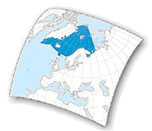
link to actual EEA report (visited 31/08/2007)
The Arctic Ocean covers a large area with harsh climatic conditions. The European part (surface area: 5 500 000 km²) of the Arctic Ocean covers only about 8 % of the total area of the Arctic Ocean, but due do its great depth it represents about 25 % of the total volume. The cold water penetrates southwards at great depths and contributes to the oxygenation of the world’s deep oceans. The formation of deep and intermediate waters in the European Arctic ocean is one of the most important features of the global oceanic circulation. The system of ocean currents induces an east-west temperature gradient with warmer conditions in the eastern part of the European Arctic Ocean, strongly influenced by the warm Gulf Stream. This keeps the Norwegian Sea and a large part of the Barents Sea ice-free and favorable for the growth of a wide range of open-sea (pelagic) and bottom-living (benthic) species. This biological production sustains huge stocks of pelagic fish in these areas.
The cold, the extreme variation in light conditions and the extensive ice cover in the area create unique marine ecosystems, and some species live on the border of their tolerance. Arctic marine food webs can be very complex, but with only a few key species connecting the different levels (OSPAR 2000). Bottom-dwelling communities can be very rich along the ice-free coasts, where kelp forests and seaweed become nursing grounds for many fish species (AMAP 1998).
As main traits to biodiversity in the Arctic Ocean are considered: climate changes, fisheries, offshore activities, shipping, contaminants, radioactive discharges and introduced species.
The three most important fish populations in the Barents Sea are herring, cod and capelin and these three species are biologically strongly linked: young herring feeds on capelin larvae, while young cod eats the mature capelin. Many seabirds (e.g. guillemots) are specialized top predators and are very sensible to changes in the lower trophic levels. Fisheries bycatch is the primary mortality factor for several seabird species.
Current and potential projects indicate that shipping probably will increase. The extreme climatic conditions heighten the risk of accidents and complicate rescue and clean-up work, thus increasing the risks of environmental damage. Oil films are frequently detected on the surface in areas of intense shipping. Other possible impacts of shipping are introduction of non-indigenous species and biological effects of antifoulants. There is a great potential for oil exploration in the Barents Sea and it is therefore likely that oil will pose a serious threat to marine life in the future.
Main political instruments discussed in the ‘EES-report’ are: the Arctic Council (the programme for the Conservation of Arctic Flora and Fauna (CAFF) and the Arctic Monitoring and Assessment Programme (AMAP) are two programmes under the Council), OSPAR, The North Atlantic Marine Mammal Commission (NAMMCO) and the Bern Convention. Further are there several national legal instruments for marine conservation in the Arctic, who are summarized by CAFF (2000b). (https://arcticportal.org/).
The research projects and monitoring programmes are mainly carried out by AMAP and CAFF (developed a ‘Strategic plan for the conservation of Arctic biological diversity’ in 1998, and the plan identifies monitoring as one of the key objectives). There are also non-governmental organizations on the field, such as the International Arctic Science Committee and the Arctic Ocean Sciences Board.
The Mediterranean Sea[5]
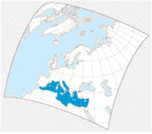
link to actual EEA report (visited 31/08/2007)
The Mediterranean Sea (surface area: 2.5 million km²) is the largest semi-enclosed European sea. The sea is oligotrophic: it is rich in oxygen and poor in nutrients. Oligotrophy increases from west to east.
The legal framework for the conservation of natural habitats and species in the Mediterranean is provided by on the one hand, conventions validly for the whole Mediterranean Sea and on the other hand conventions which are only valid for the European Member States along the northern shore of the sea (e.g. Convention through the protection of coastal and marine habitats and species, provided by the EU Birds and Habitats Directives).
The fauna and flora is one of the species richest of the world and there is a high rate of endemism. Compared with the Atlantic, the Mediterranean marine communities have many different species with generally smaller individuals (Mediterranean nanism) having a shorter life cycle. The oligotrophic water results in low primary production rates, combined with poor development of higher levels of the food chain, including low fish production.
Eutrophication, microbial contamination, fishing, exploitation of living resources and mariculture, industrial and oil pollution and the establishment of alien species are considered as main threats to biodiversity in the Mediterranean Sea.
Eutrophication in coastal areas has almost certainly resulted in an increase in fish catches of some pelagic fish species in the formerly low-nutrient waters of the Mediterranean Sea
Introduction of alien species through ballast water, fouling, import and invasion has resulted in the establishment of dense populations of invading species. The impact of some intruders, such as the tropical alga Caulerpa taxifolia has had catastrophic effects on the natural environment.
Fishing has resulted in overexploitation of several fish stocks in the Mediterranean. Mortality of the monk seal (Monachus schauinslandi) is mostly associated with fishing. Over exploitation by intensive collection has led to a serious decline in some corals and many shellfish.
The EEA report reproduces a list of conventions, directives and action plans for nature protection in the Mediterranean Sea.
There are 47 SPA (Specially Protected Area) sites witch cover marine Mediterranean areas under the UNEP Protocol. But among the signatories of the protocol, only Italy has specific legislation for the establishment of marine protected areas.
The research and monitoring programmes are focused on pollution assessment. Presently no monitoring of plankton, benthos or fish is undertaken at the Mediterranean scale and the Mediterranean cetology is still in its infancy.
The Black Sea[6]
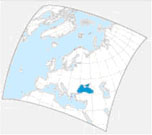
link to actual EEA report (visited 31/08/2007)
Nearly 87 % of the Black Sea (surface area: 423 000 km²) is entirely anoxic (without oxygen) and contains high levels of hydrogen sulphide. This is the result of past geological events, its shape and its specific water balance (high degree of isolation from the world ocean, deep water depression in the centre of the sea, the extensive drainage basin and the large number of incoming rivers).
Due to anoxia in large parts of deeper waters, deep pelagic and benthic organisms are largely absent. The structure of marine ecosystems differs from the neighboring Mediterranean Sea by a lower species variety (ratio of the Mediterranean to Black Sea for species richness is three) and the dominant groups are different. However the total biomass and productivity of the Black Sea is much higher.
The considered main threats to biodiversity in the Black Sea are eutrophication, contamination and oil pollution, water management and regulation, fisheries and alien species.
The wide diversity of biotopes provides favorable conditions for invasions of alien species to the Black Sea. The composition and structure of the marine communities is constantly changing with the decline of certain species and the expansion of others.
Increasing salinity due to inappropriate water management and regulation, and pollution of brackish coastal lakes and estuaries represents a threat to relics and endemic species, especially in the Sea of Azov.
Deterioration of some marine habitats and a lack of laws and technology for regulating the introduction of alien species, for example via ballast waters, have allowed the invasion of such species. A prominent example of an alien species is that of the comb jellyfish Mnemiopsis leidyi. These have produced mass populations, what have changed the equilibrium of the native marine ecosystems.
The Convention on Biological Diversity has been signed and ratified by all Black Sea countries, however there is no univocal legislation for the specific conventions, validly for all Black Sea countries. For example, no overall management of fish stocks in the Black sea is in place (the convention on Fishing in the Black Sea has not been signed by Turkey). MARPOL (Prevention of Marine Pollution from ships) have already come into force but are only slowly being implemented. There are more than 20 nature reserves in the Black Sea, but many reserves still lack effective management plans and infrastructure.
The Black Sea Environmental Programme (BSEP) is set up in 1993, to provide a sustainable basis for managing the Black Sea. The most important realizations of the BSEP are the Trans boundary Diagnostic Analysis of the Black Sea (GEF-BSEP/UN, 1997) and the publications of the Black Sea Red Data Book (GEF-BSEP/UN, 1999).
The Caspian Sea[7]
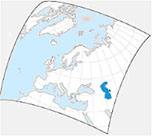
link to actual EEA report (visited 31/08/2007)
The Caspian Sea is the largest (surface area: 390 000 km²) enclosed sea in the world. It is brackish, with salinity up to 13.7 ‰. The typical brackish-water fauna formed as from the Mid-Pliocene, when the Caspian Sea was completely isolated from the Black Sea.
One of the most important features of the Caspian Sea is its changing water level, which has a significant effect on biodiversity in the extensive shallow areas. The factors causing these fluctuations are not well understood and causes are hotly debated.
The high biological diversity of the Caspian Sea makes the region one of the most valuable ecosystems. Many species are endemic and there are many representatives from almost all major groups on earth. The most important fauna of the Caspian Sea is the sturgeon, which constitute 85 % of the standing stock of the world’s sturgeon population. The Caspian Sea lies on the crossing of migration routes of millions of migrating birds and offers refuge for a number of rare and endangered birds.
The considered main threats to biodiversity in the Caspian Sea and its coastal zone are combinations of natural and anthropogenic factors including pollution, sea level fluctuation, river regulation, poaching over overfishing and introduction of alien species.
Regulation of the Caspian rivers, causing reduction in the area of delta vegetation, loss of reeds, cattail and bushes. Loss of vegetation results in loss of aquatic and coastal fauna. Many anadromous and semi-migratory species have been deprived of their natural spawning grounds.
Most of the threats to the biodiversity of the Caspian are trans boundary in nature and require effective measures from all Caspian states, for this reason is the Caspian Environment Programme (CEP, 1998) launched by the riparian states.
Since the collapse of the Soviet Union, the legal framework for the fishery changed and this created a difficult situation for the management of the sturgeon resources.
There has been little study on the biodiversity of the Caspian Sea. There is an urgent need to undertake an ecological survey of the coastal and marine species and habitats, their uses, values and threats, for each of the five Caspian states, which will result in an inventory of Caspian ecological resources. Strategies for the management of trans boundary biodiversity, including threatened or endangered migratory species need to be developed.
References
- ↑ 1.0 1.1 EEA (2002). Europe`s biodiversity - biogeographical regions and seas - Seas around Europe - The North Sea Cite error: Invalid
<ref>tag; name "North Sea" defined multiple times with different content - ↑ 2.0 2.1 EEA (2002). Europe`s biodiversity - biogeographical regions and seas - Seas around Europe - The Baltic Sea
- ↑ 3.0 3.1 EEA (2002). Europe`s biodiversity - biogeographical regions and seas - The North-east Atlantic Ocean
- ↑ 4.0 4.1 EEA (2002). Europe`s biodiversity - biogeographical regions and seas - The Arctic Ocean
- ↑ 5.0 5.1 EEA (2002). Europe`s biodiversity - biogeographical regions and seas - seas around Europe - The Mediterranean Sea
- ↑ 6.0 6.1 EEA (2002). Europe`s biodiversity - biogeographical regions and seas - seas around Europe - The Black Sea
- ↑ 7.0 7.1 EEA (2002). Europe`s biodiversity - biogeographical regions and seas - seas around Europe - The Caspian Sea
Please note that others may also have edited the contents of this article.
|

